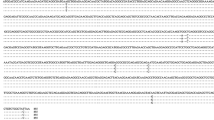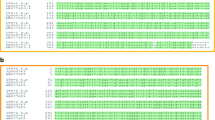Abstract
Shellfish can cause severe anaphylactic reactions. Tropomyosin has been assumed partly responsible for the cross-reactivity among shellfish and other invertebrates. In this study, cDNA of Sinonovacula constricta was amplified by RT-PCR and 3′-RACE from total RNA. The obtained tropomyosin cDNA included an open reading frame coding for 284 amino acids. The deduced amino acid sequence of the corresponding protein shared high identity with other allergenic tropomyosins. Expression of the recombinant tropomyosin was carried out in Escherichia coli BL21(DE3) using vector PET28a and the purification of the recombinant protein was performed via affinity chromatography. IgE reactivity of recombinant tropomyosin was investigated by immunoblot and the sensized precentage was 36% which indicated that tropomyosin was the minor allergens in S. constricta. Moreover, the character of the purified protein was analyzed by MALDI-TOF-MS.






Similar content being viewed by others
References
Burks AW, Sampson HA (1993) Food allergies in children. Curr Probl Pediatr 23:230–252
Jansen JJ, Kardinaal AF, Huijbers G et al. (1994) Prevalence of food allergy and intolerance in the adult Dutch population. J Allergy Clin Immunol 93:446–456
Sampson HA (2004) Update on food allergy. J Allergy Clin Immunol 113:805–819
Fuller HR, Goodwin PR, Glenn EM (2006) An enzyme-linked immunosorbent assay (ELISA) for the major crustacean allergen, tropomyosin, in food. Food Agric Immunol 17:43–52
Lehrer SB, Ayuso R, Reese G (2002) Current understanding of food allergens. Ann NY Acad Sci 964:69–85
Leung PS, Chu KH (1998) Molecular and immunological characterization of shellfish allergens. Front Biosci 3:306–312
Thong BYH, Cheng YK, Leong KP et al. (2007) Immediate food hypersensitivity among adults attending a clinical immunology/allergy centre in Singapore. Singapore Med J 48:236–240
Lehrer SB, Ayuso R, Reese G (2003) Seafood allergy and allergens: a review. Mar Biotechnol 5:339–348
Shanti KN, Martin BM, Nagpal S (1993) Identification of tropomyosin as the major shrimp allergen and characterisation of its IgE-binding epitopes. J Immunol 151:5354–5363
Daul CB, Slattery M, Reese G (1994) Identification of the major brown shrimp (Penaeus aztecus) allergen as the muscle protein tropomyosin. Int Arch Allergy Immunol 105:49–55
Leung PSC, Chu KH, Chow WK et al. (1994) Cloning, expression, and primary structure of Metapenaeus ensis tropomyosin, the major heat-stable shrimp allergen. J Allergy Clin Immunol 94:882–890
Leung PSC, Chen YC, Mykles DL et al. (1998) Molecular identification of the lobster muscle protein tropomyosin as a seafood allergen. Mar Mol Biol Biotech 7:12–20
Leung PSC, Chen YC, Gershwin ME et al. (1998) Identification and molecular characterization of Charybdis feriatus tropomyosin, the major crab allergen. J Allergy Clin Immunol 102:847–852
Hefle SL, Bush RK, Lehrer Sb et al. (1995) Snow crab allergy: Identification of IgE-binding proteins. J Allergy Clin Immunol 95:322
Leung PS, Chu KH (2001) cDNA cloning and molecular identification of the major oyster allergen from the Pacific oyster, Crassostrea gigas. Clin Exp Allergy 31:1287–1294
Miyazawa H, Fukamachi H, Inagaki Y et al. (1996) Identification of the first major allergen of a squid (Todarodes pacificus). J Allergy Clin Immunol 98:948–953
Motoyama K, Ishizaki S, Nagashima Y et al. (2006) Cephalopod tropomyosins: identification as major allergens and molecular cloning. Food Chem Toxicol 44:1997–2002
Santos ABR, Chapman MD, Aalberse RC et al. (1999) Cockroach allergens and asthma in Brazil: identification of tropomyosin as a major allergen with potential cross-reactivity with mite and shrimp allergens. J Allergy Clin Immunol 104:329–337
Jeong KY, Lee J, Lee IY et al. (2003) Allergenicity of recombinant Bla g 7, German cockroach tropomyosin. Allergy 58:1059–1063
Aki T, Kodama T, Fujikawa A et al. (1995) Immunochemical characterization of recombinant and native tropomyosins as a new allergen from the house dust mite, Dermatophagoides farinae. J Allergy Clin Immunol 96:74–83
Reese G, Ayuso R, Lehrer SB (1999) Tropomyosin: an invertebrate pan-allergen. Int Arch Allergy Immunol 119:247–258
Jeong KY, Hong CS, Yong TS (2006) Allergenic tropomyosins and their cross-reactivities. Protein Pept Lett 13:835–845
Leung PS, Chow WK, Duffey S et al. (1996) IgE reactivity against a cross-reactive allergen in crustacea and mollusca: evidence for tropomyosin as the common allergen. J Allergy Clin Immunol 98:954–961
Chu KH, Wong SH, Leung PS (2002) Tropomyosin is the major mollusk allergen: reverse ttranscriptase polymerase chain reaction, expression and IgE reactivity. Mar Biotechnol 2:499–509
Song JJ, Zhang HY, Liu ZG et al. (2007) Mango profilin: clonging, expression and cross-reactivity with birch pollen profilin Bet v 2. Mol Biol Rep (in press). doi 10.1007/s11033-007-9075-5
Shevchenko A, Wilm M, Vorm O (1996) Mass spectrometric sequencing of proteins from silver stained polyacrylamide gels. Anal Chem 68:850–858
Crespo JF, Pascual C, Helm R et al. (1995) Cross-reactivity of IgE binding components between boiled Atlantic shrimp and German cockroach. J Allergy Clin Immunol 50:918–924
Laffond Yges E (1996) Reacciones alérgicas por moluscosy crustáceos. Allergol Immunol (Madr) 24:36–44
Wu AY, Williams GA (2004) Clinical characteristics and pattern of skin test reactivities in shellfish allergy patients in Hong Kong. Allergy Asthma Proc 25:237–242
van Ree R, Antonicelli L, Akkerdaas JH et al. (1996) Possible induction of food allergy during mite immunotherapy. Allergy 51:108–113
Fernandes J, Reshef A, Patton L et al. (2003) Immunoglobulin E antibody reactivity to the major shrimp allergen, tropomyosin, in unexposed Orthodox Jews. Clin Exp Allergy 33:956–961
Asturias JA, Eraso E, Arilla MC et al. (2002) Cloning, isolation, and IgE-binding properties of Helix aspersa (brown garden snail) tropomyosin. Int Arch Allergy Immunol 128:90–96
Acknowledgments
Authors thank Mr. Yong Wang for the MALDI-TOF-MS analysis and the Shenzhen people’s hospital for kindly sera supporting. This study was supported by National 863 high technology research (No. 2006AA100308).
Author information
Authors and Affiliations
Corresponding author
Additional information
Juanjuan Song and Li Li contributed equally to this work.
Rights and permissions
About this article
Cite this article
Song, J., Li, L., Liu, Z. et al. Sequence analysis and expression of a cDNA clone encoding tropomysin in Sinonovacula constricta . Mol Biol Rep 36, 315–321 (2009). https://doi.org/10.1007/s11033-007-9181-4
Received:
Accepted:
Published:
Issue Date:
DOI: https://doi.org/10.1007/s11033-007-9181-4




